 News coverage of the riots and deaths stemming from rage at the short movie, “Innocence of Muslims” reminded me of a Catholic News Agency article by Michele Bauman I read in my local diocesan paper a couple of weeks ago. It’s title, “Study Reveals Increasing Hostility in US Toward Religion” caught my attention. “I’m not surprised,” I thought, and placed it on my desk, intending to comment in this blog. There the article remained until this morning’s news moved me to write the post.
News coverage of the riots and deaths stemming from rage at the short movie, “Innocence of Muslims” reminded me of a Catholic News Agency article by Michele Bauman I read in my local diocesan paper a couple of weeks ago. It’s title, “Study Reveals Increasing Hostility in US Toward Religion” caught my attention. “I’m not surprised,” I thought, and placed it on my desk, intending to comment in this blog. There the article remained until this morning’s news moved me to write the post.
First, a little background on the groups that put out the study cited in the CNA article. One, the Liberty Institute headed by Kelly Shackelford, is a conservative Christian advocacy group that focuses much of its attention on pro bono legal cases involving people or churches who believe their first amendment rights are being violated on the grounds of their Christian faith. A prominent case, dubbeded the “Candy Cane Case,” defends the right of a young student to bring candy canes with a religious story attached to the class Christmas party.
The second organization is Family Research Council, headed by Tony Perkins. This group was designated a “hate group” by the Southern Poverty Law Center in 2010 for its dissemination of “false and denigrating propaganda about LGBT people.” The Human Rights Campaign’s president, Chad Griffin writes in the Washington Post’s Opinion page that “The real issue is the Family Research Council’s well documented and continuous pattern of hateful rhetoric.” Hardly credentials for writing about hostility against a group of people.
I downloaded the Executive Summary of “Survey of Religious Hostility in America” and as one would expect from such groups, the only “religious hostilities” mentioned are those perceived against Christians or Christian churches or causes. What about cases of hostility against Muslims, Jews, or non-believers? Our country is not homogenous in any way: ethnicity, race, or religion. As a country we must be respectful of everyone’s right to believe and worship, or not, according to his or her beliefs or lack of belief.
Such respect was not given to Muslim believers by the makers of the film mentioned above, ridiculing Mohammed and portraying him as violent and obsessed with sex. According to an AP article by Michale R. Blood, the permit for the film has been connected to a Christian charity, Media for Christ. Sigh.
So you see why, when I saw the headlines of the CNA article in my local Catholic paper, my response was not surprise. With hate-filled rhetoric and religious extremists on every side, why wouldn’t the general public have less and less respect for religion? Why one might feel hostility toward organized churches is not difficult to comprehend.
I am not advocating it, of course. Most people who attend religious services and who claim belief in God do not go out and make offensive movies, hurl bricks through windows of Muslim owned businesses (This comes to mind from conversations with friends in Minnesota who are trying to reach out to the Somali population there.), or denigrate Jews. It just doesn’t go along with believing in a loving God.
Nor does spewing hate-filled rhetoric about gay, lesbian, transsexuals, or transgendered people. Or people of minority races. Or atheists. Or anyone else.
Like most God-fearing people, I am tired of the extreme wings of any faith grabbing headlines and that is what the CNA article has done. It, and articles like it, fan the flames of violence and intolerance that are spreading around the world.
Let’s look for leadership from places other than those who plant themselves squarely on the far fringes of believers.
 “Blue Moon Over Cincinnati” Bill Ingalls/NASA via Getty Images (Originally published in the Catholic Times, September 9, 2012 © 2012 Mary van Balen)
“Blue Moon Over Cincinnati” Bill Ingalls/NASA via Getty Images (Originally published in the Catholic Times, September 9, 2012 © 2012 Mary van Balen)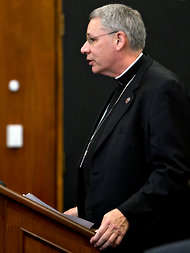

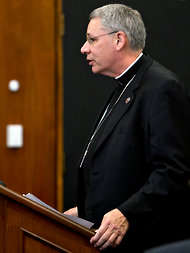 The Catholic hierarchy is notoriously secretive. When they backslide again it will be hard to catch them, everyone involved must be hyper vigilant if kids are truly to be safe.
The Catholic hierarchy is notoriously secretive. When they backslide again it will be hard to catch them, everyone involved must be hyper vigilant if kids are truly to be safe.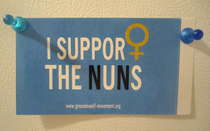
 Sister Simone Campbell at the DNC On Wednesday, the Nuns on the Bus arrived at the Democratic National Convention and one of them, Sister Simone Campbell, stood on the podium to remind those with ears to hear that the Romney/Ryan budget “failed a moral test,” echoing the statement of the United States bishops.
Sister Simone Campbell at the DNC On Wednesday, the Nuns on the Bus arrived at the Democratic National Convention and one of them, Sister Simone Campbell, stood on the podium to remind those with ears to hear that the Romney/Ryan budget “failed a moral test,” echoing the statement of the United States bishops. 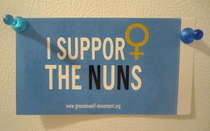 As election day approaches, people of faith, no matter the denomination, have much to consider, including the implications of adoption of the Republican budget that includes huge tax cuts for the wealthiest, repeal of the Affordable Care Act, and budget cuts in programs like food stamps.
As election day approaches, people of faith, no matter the denomination, have much to consider, including the implications of adoption of the Republican budget that includes huge tax cuts for the wealthiest, repeal of the Affordable Care Act, and budget cuts in programs like food stamps.
 from the film: “The Intouchables” (Originally published in the Catholic Times, August 26, 2012 © 2012 Mary van Balen)
from the film: “The Intouchables” (Originally published in the Catholic Times, August 26, 2012 © 2012 Mary van Balen) Then there was the Public Marketplace, as noisy and crowded as the garden was quiet and nearly empty. Booth after booth of fresh flowers were a riot of color and reminded me a bit of Thailand markets. Jewelry, clothing, artwork, fruits, vegetables, and yes, the fish market where crabs and whole salmon are tossed about. So NOT Ohio.
Then there was the Public Marketplace, as noisy and crowded as the garden was quiet and nearly empty. Booth after booth of fresh flowers were a riot of color and reminded me a bit of Thailand markets. Jewelry, clothing, artwork, fruits, vegetables, and yes, the fish market where crabs and whole salmon are tossed about. So NOT Ohio.

 I thought about these things as I drove to spend the morning with my sister-in-laws learning to cook a healthy, meatless meal. My sister and I had a great time and eventually brought home some delicious food for dinner. I mentioned Rose of Lima and my discoveries about her.
I thought about these things as I drove to spend the morning with my sister-in-laws learning to cook a healthy, meatless meal. My sister and I had a great time and eventually brought home some delicious food for dinner. I mentioned Rose of Lima and my discoveries about her. 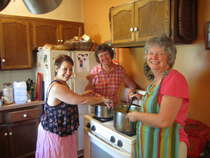 Or maybe working two jobs to make ends meet. Or using the free time economic security provides to volunteer somewhere. It can mean eating less and more healthily (as my morning of cooking prodded me to consider), consuming less material goods. Just allowing oneself times of quiet and prayer can be challenging today.
Or maybe working two jobs to make ends meet. Or using the free time economic security provides to volunteer somewhere. It can mean eating less and more healthily (as my morning of cooking prodded me to consider), consuming less material goods. Just allowing oneself times of quiet and prayer can be challenging today.  “Gratia Plena” by Stephen Heilmer PHOTO: Mary van Balen
“Gratia Plena” by Stephen Heilmer PHOTO: Mary van Balen  Abbot John Klassen OSB PHOTO: Sr. Edith OSB Part Two: “I am doing something NEW….”
Abbot John Klassen OSB PHOTO: Sr. Edith OSB Part Two: “I am doing something NEW….” PHOTO: Mary van Balen No need to remember past events, no need to think about what was done before.
PHOTO: Mary van Balen No need to remember past events, no need to think about what was done before.